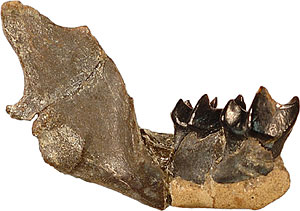About UCMP : News and events : UCMP newsletter
UCMP's MIOMAP: mapping the past to forecast the future
by Tony Barnosky
Humans are changing the ecology of Earth in many ways directly through building cities, dams, and roads, and indirectly by contributing to global warming. The question that is becoming critical to answer is: "How do we know when the changes we see today signal a dangerous trajectory of ecological change?" One way to answer that question is to look to the past in order to learn what kinds of ecological changes can be considered "natural," and then to examine the changes we see today and identify which fall outside that range. The problem with actually doing that, however, is that it requires pulling together an immense amount of paleontological information—specifically, who lived where and when—that is needed to reconstruct past ecosystems, in order to understand how those ecosystems worked.

MIOMAP's image library provides high-quality images of Miocene type specimens in UCMP holdings, allowing researchers to take a virtual look at the collections. This is the outer view of the lower jaw of UCMP 29600, Metechinus nevadensis, from the Fish Lake beds of Nevada. The jaw is about 4 cm from back to front. Additional images of this specimen can be found here.
|
 |
Some of UCMP's researchers have now built a web-based resource, called MIOMAP that contributes to solving that problem. Scientists and the public worldwide can use MIOMAP to learn what mammals lived where within the U.S. through much of the past thirty million years. MIOMAP also includes an image library, which is being built to allow digital access to high-quality images of type specimens held in UCMP's collections. Recently featured in Science Magazine's Netwatch, the MIOMAP site provides data for a wide spectrum of scientific applications, ranging from evolutionary and ecological studies to land management.
Over the past five years, Professor Tony Barnosky and Postdoctoral Researcher Marc Carrasco, with the help of graduate students (Brian Kraatz, Alan Shabel, Jenny McGuire, and recent Ph.D. Edward Davis) constructed MIOMAP specifically to address ecological questions such as how biodiversity of mammals has changed in response to climate changes in the past. This information will help to predict the biodiversity changes we might expect from global warming that is now underway. Initially, their work focused on one part of the geological time scale, the Miocene, which runs from about 24 to 5 million years ago (hence the name MIOMAP, short for Miocene Mammal Mapping Project), but they quickly expanded to include earlier times (all of the Neogene, back to about 30 million years ago). Current efforts are underway to integrate MIOMAP with other databases, such as FAUNMAP, which is the Pleistocene counterpart to MIOMAP, and other museum collections databases such as The Paleontology Portal. The goal is to provide seamless analysis of mammal biodiversity from the present back to millions of years ago.
In order to assemble the information for MIOMAP, the researchers first combed the published scientific literature to dig out all reported discoveries of fossil mammals. They then extracted information such as the species and latitude, longitude, age, and associated geological information of the locality, and entered it into a database that is stored on the UCMP server. Various programs find that data and serve it to answer web-based queries about which animals were present in a given place and time. From that information, Barnosky and Carrasco hope to trace how biodiversity of mammals naturally fluctuates over long time periods, and how that compares with what has happened over our human lifetimes.
While the answer to that major question is still forthcoming, the MIOMAP team already has made some important discoveries. For example, they have found that it may take a major transition in climate state — like the shift into Ice Ages after millions of years without Ice Ages — for climate to change continental-scale patterns of biodiversity. The looming question is whether human-caused global warming will initiate such continental-level biodiversity shifts in the coming decades. And, the MIOMAP team also has verified that in order to trace biodiversity through time, it is very important to control for sampling over varying geographic areas — something that has been hard to do in past studies but which MIOMAP makes relatively easy.
To learn more about discoveries from MIOMAP, visit these online resources:
